Humanity is facing a grave crisis. This crisis originates in a small molecule: carbon dioxide. There isn’t a high concentration of CO2 in the atmosphere, but its effect is enormous. Through the release of carbon dioxide, we are warming our planet as we are permanently burning petrol, diesel, coal, gas and other fossil fuels, emitting CO2 – lots of CO2, tons of it in fact. ECO123 is writing today about the climate crisis, a formidable challenge which demands action-based solutions. How can we solve this problem?
There’s no point in beating about the bush: eight months after the challenge began, 85 of the 100 participants have already abandoned it. Many do not have the willpower to keep filling in the forms. Some participants distort the true value of their emissions, and others have no idea how much pollution they create with their cars. Perhaps some people would only become aware of this pollution if the exhaust fumes started entering into the car itself…
However, we are pleasantly surprised by those participants who persist with the challenge. There are 15 people on track to complete it. After eight months, they are two thirds of the way there. This report will focus on these 15 participants. Here, we ask: how realistic is this challenge of limiting emissions to 3 tons of CO2 per person per year in 2020? And how might it impact on their everyday life? Of these 15 participants, the experiences of seven will appear in this report, as these participants have given their permission to be included here.
A journey through time and space
Today, in Portugal, there are about 10.3 million people. They are responsible for emitting around 54 million tons of CO2 per year (that’s 9% less than in 2017). On average, each person living in Portugal emits around five tons of CO2 per year. KYOTO aims to help people understand what this value means in relation to everyday life. This is five tons per year which now, suddenly, should be reduced by 40%. Five tons of CO2 emissions per person per year is two tons more than it should be, right? In Europe, we want each individual’s carbon footprint to be 40% lower by 2030. And does that include politicians? By the year 2050, we aim to achieve carbon neutrality. Zero emissions? And how do they expect us to achieve this? This is our question. How can these emissions be calculated? How can we find out how much CO2 is generated by the burning of fossil fuels while we consume food products, use cars and power our households? This is precisely why ECO123 came up with the KYOTO challenge, and today, after eight months, we present you with the first mid-term review.
Seven out of fifteen
José, aged 62, is a freelance IT technician, who earns around €1000 per month. As he told us during an interview in a previous edition of ECO123 (#25), he works part time in order to be able to spend more time with his family. This statement deserves to be emphasised! He knows about the KYOTO challenge because he has been reading ECO123 for five years. His diet includes meat three times a week, or fish. And how does he get to work? He drives a Honda Civic hybrid that emits 109g of CO2 per kilometre, but he doesn’t always travel by car. He travels around 600km a month, and he often takes the metro or the bus. He gets his electricity from Coopérnico. We met him on 9 February, 2019, in one of the rooms at the Science Faculty in Lisbon, on the day of the KYOTO presentation. José was the first participant to sign up.
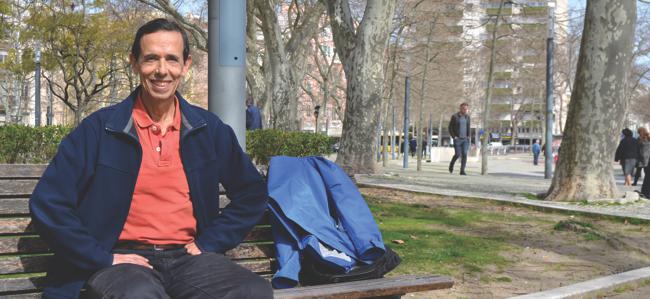
Elisabete, aged 50, used to work in a bank, but is now retired. She lives with her husband in the north of Lisbon. They signed up to KYOTO to get a better idea of their carbon footprint. She’s never done anything like this before. She was the fifth participant to sign up. Elisabete and her husband were intending to fly to Iceland on holiday in September. How might this flight affect her climate balance?
Lénia, aged 36, has a small daughter. She earns €800 per month and receives a widow’s pension. She lives in the region of Porto and drives a Fiat that emits 130g of CO2 per kilometre. She’s an EDP customer, and has been reading ECO123 for four years. She was the tenth participant to sign up.
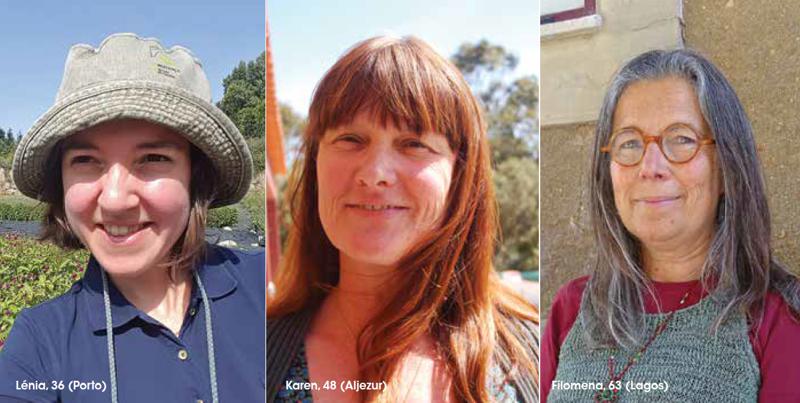
Karen, aged 48, was born in Scotland. She is the headteacher of the international school in Aljezur and was the fourteenth participant to sign up to KYOTO. She is a vegetarian and drives a Renault Clio that emits 83 kg of CO2 per kilometre. She flies back to her home country in Northern Europe twice a year. What will she do to make sure that she doesn’t use more than 3000 kyotos over the course of a year?
Paul, aged 70, is from Germany and lives near Viseu. He was the 35th participant to sign up. He’s been reading ECO123 for a few months. We can see that Paul is someone who knows how to live simply. He produces his own solar energy and drives a Renault Kangoo ZE, which he charges at home. How will he get on with the challenge?
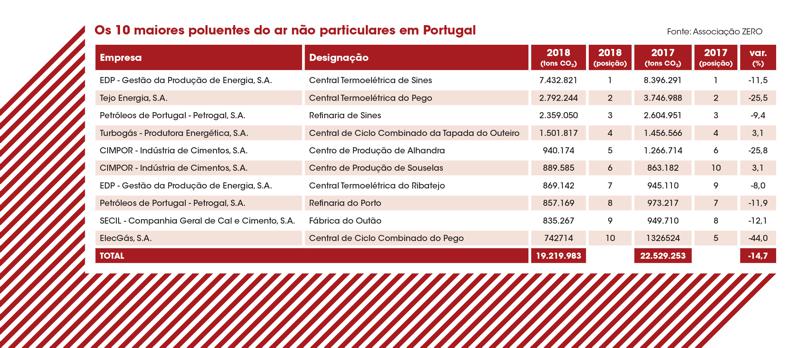
Diana, aged 55, is a Portuguese scientist who lives and works in Oslo, where she teaches at the university. She comes from Lisbon and visits the city at least once a year. She eats meat and fish every day, which is typical in Norway. To travel to work within the city, she takes the metro. Will this effectively reduce her carbon footprint?
Filomena, aged 63, is an artisan, who lives in a small village near Lagos, in the south of Portugal. She worries that the 3000 kyotos might not be enough for her, as she often travels by car between Lagos and Lisbon. During the challenge, she will change her behaviour and take this journey more often by train. She’s also thinking of switching to a renewable energy supplier. We’ll see if she is successful in reducing her CO2 emissions as this story unfolds.
A happy ending?
This story is not fictional. It’s a tale that has never been written this way before: a project that took a long time to prepare, a documentary account. Truman Capote was an inspiration to us here at ECO123; all of his writing was based on real documents, from Breakfast at Tiffany’s to In Cold Blood. For this reason, we would like to make it clear that all seven participants have authorised us to write about them, from the inclusion of their names to the publication of this project’s results. The challenge began in the first week of March 2019, when all of the participants were given access to their online KYOTO accounts. These accounts were initially credited with 3000 kyotos each. We were also interested in seeing whether eco-friendly attitudes were influenced by the participants’ financial status, a point raised by climate researcher João Camargo during the presentation of the challenge in Lisbon. Could this be the case? This is a fundamental question. Will their awareness of the issues shape their situation, or will their situation influence their awareness? Let’s find out later, when this question will be addressed in greater detail. It is also important to point out that these seven participants were already aware of many issues relating to climate change. When filling out a profile for a KYOTO, each participant answered the following question: are you willing to change your world? What must these participants do now to apply the Kyoto Protocol, 22 years later? They say that they are curious, environmentally aware and willing to learn. From the very beginning, they knew that travelling by car, flying and eating meat increases their carbon footprint. So let’s see how this story develops during the first eight months of the project – and how it might end once the year is through.
Knowledge is everything, and without knowledge everything is nothing
KYOTO is different in that it is designed to feel like a game. We already know that a challenge which takes place over an extended period of time can become boring, and that participants have a tendency to give up after a number of weeks. KYOTO continually asks its participants: how are you? Are you happy? Are you doing well? Are you optimistic? Can you find solutions to your problems? ECO123 puts together a monthly quiz, with nine questions on the subject of the climate. For every correct answer, participants can regain ten kyotos. There isn’t a quiz to complete every day. Miguel Almeida, a director of Portugal’s first cooperative energy supplier Coopérnico, and Alfredo Cunhal-Sendim, from Herdade Freixo do Meio (Montemor-o-Novo), both know this. They are part of KYOTO’s advisory council and help to develop quiz questions for their respective areas: renewable energy and organic farming. Over the course of the year, participants can win back 1080 kyotos in this way, which helps to compensate for flights and improves their climate balance.
But there’s more: the KYOTO challenge also takes “climate offset” compensation into account. Those who choose to pursue this option will find benefits both for themselves and for the planet. Participants who produce more renewable energy than they consume and feed it back into the grid are eligible for extra awards. For every kW/h of clean energy provided, half a kyoto is credited to their accounts. The online form also asks participants: how many trees have you planted this week? For each tree planted, ten kyotos are credited to their accounts. Participants start to see that their balance may increase as well as decrease. These rewards are dependent on their efforts. Paul, the smart guy of the group, planted 49 trees in April and 32 trees in October, adding an extra 490 – and then 320 – kyotos to his account. We will see how many of these trees succeed at the end of the year and appear the following spring. It is not simply a question of planting the trees but maintaining them too, which means continuous work.
And not everyone impacts on the climate in the same way. For this reason, there are political issues around how we might achieve a socially just transition to climate neutrality in Portugal and in Europe. ECO123 can provide politicians with answers if the data provided by the seven participants is analysed and observed, suggesting possible ways out of the current climate crisis. Eight months after the project began, information from KYOTO highlights key solutions which are within everyone’s reach. We are able to see how we can avoid emitting several tons of CO2 per year without making any alterations to our social system. We know that we need to decommission coal-fired power stations, and that there is a lot to be done both in Portugal and across Europe. This challenge, however, focuses on the individual rather than politics, on people who have the capacity to change themselves. We would like to limit our emissions to three tons of CO2 per year. How can we manage this? Where can we start?
KYOTO: a strategy of 1+1+1=3
First off, let’s say that mathematics can help us to understand our goals. This means that, besides actively participating in life, we ought to set ourselves ecological goals and then try and meet them one step at a time. If one ton of CO2 is allocated to consumption, and the same amount is allocated to both transport and household energy expenditure, that makes three tons in total. But how can this theory be put into practice on a day-to-day basis? Karen, the Scottish teacher in Aljezur, is on the right track by sticking to a vegetarian diet and shopping locally. Over 52 weeks, these actions make a difference. People who eat meat and fish generate between 1.7 and 4.6 tons of CO2 emissions per year from food consumption alone; people who choose to be vegetarian generate around 1.1 tons of CO2 per year. If we buy our basic foodstuffs locally instead of relying on processed, frozen and packaged items, we can reduce our carbon footprint by another 500 kg. For example, if you buy 1kg of frozen chips from a supermarket, this generates around 5kg of CO2 emissions due to the processing, transport and cold-chain costs involved in producing and preserving these chips. But, if you buy your potatoes directly from a farmer at a market, you only generate 200g of CO2 according to the EEA*. That’s a big difference. And a vegetarian has a much smaller carbon footprint than someone who eats meat and fish.
*European Environment Agency, Copenhagen
STOP, writes Júlia from Silves in the south of Portugal, who doesn’t accept this fact. In protest, she gave up on the KYOTO challenge and cancelled her six-year-long subscription. You’re generalising, and unfairly criticising people who eat meat! What if I source my meat locally and sustainably, or eat game? ECO123 shouldn’t penalise participants in this way. ECO123 responds to her by saying that sustainable meat production and hunting account for less than 3% of overall meat consumption in Portugal. This figure was already taken into consideration during the programming of KYOTO. However, we asked ourselves if there were not today more pressing issues concerning the marketing of dead animals, of meat. Should intensive livestock production be considered a form of torture? In the KYOTO challenge, vegans score more highly than vegetarians. Of the initial 100 participants, four were vegans. However, just like Júlia, they gave up on the challenge after six weeks.
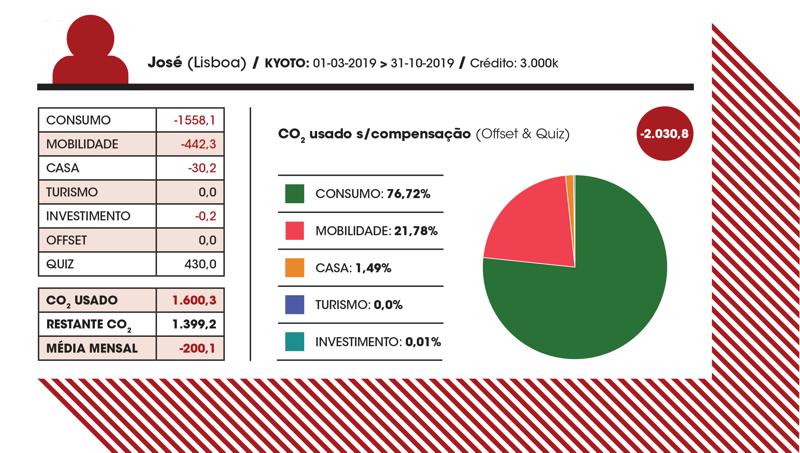
José, who lives in a 50m2 apartment in Lisbon with his family, doesn’t travel by plane and, when travelling within the city, he usually takes the bus or the metro. During May, he only spends 39.5k (kyotos) for transport. In June, he spends 73.9k, and, in August, he spends 34.9k. All in all, over the first eight months, José spends only 442.1k – this is sticking to the strategy of not flying, travelling on public transport and driving his hybrid Honda Civic. If he carries on like this, his emissions will come in at well below one ton for the year and he will meet his goal. In late October, he still has 1399.4k left.
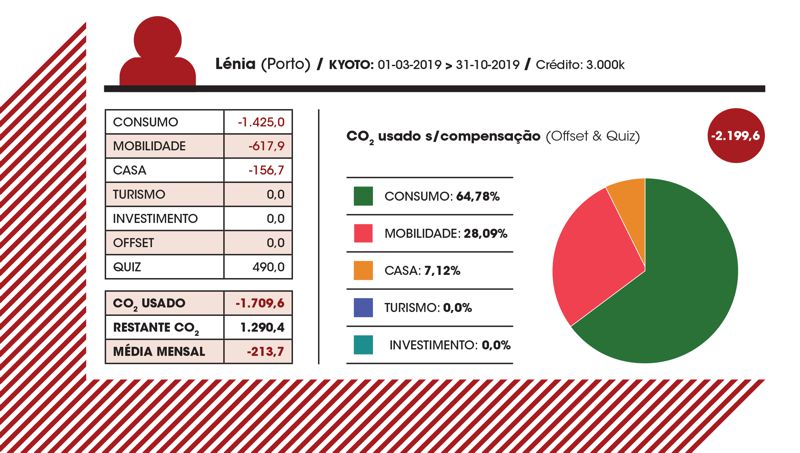
Lénia, who lives in the region of Porto, does not modify her lifestyle. Although she doesn’t intend to exceed KYOTO’s credit limit, she doesn’t change her life. She notes that she recycles 75% of her rubbish. This includes bottles, paper and wood, but the majority of it is plastic. There is also some undifferentiated waste that she doesn’t know what to do with. Over eight months, this amounts to 160k, although data from the third week of July and the second week of September are missing. She promises to enter these data during the last month of the year. Weekly calculations of carbon footprints involve a lot of work, and even the newsletter – a weekly reminder of this task – can be a nuisance. That’s why we once decided to send the newsletter without any words – we wanted to check if participants were still paying attention. Only one participant noticed what had happened. She asked if, in the future, all newsletters could all be written wordlessly. After eight months, Lénia’s carbon footprint already amounts to 1425k, exceeding the credit allowance by 50%. Changing consumption habits might help to reduce this value. She could do less of her shopping at the supermarket and buy more packaging-free products at local markets instead. Eating meat and fish once a week instead of three times a week would also help to reduce emissions. By establishing new habits, she could reduce her carbon footprint by 50%. At the end of October, she still has 1290.4k left.
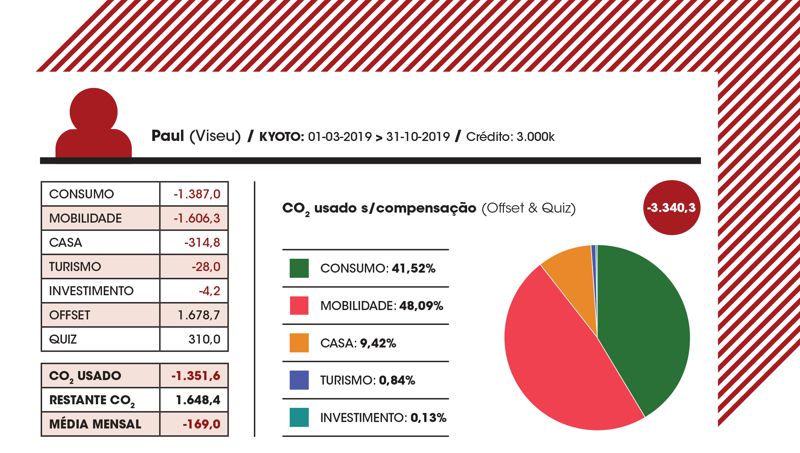
Let’s return to Paul, from Viseu. He always has a calculator to hand to check his remaining KYOTO balance. He buys an electric car, a Kangoo Z.E., and charges it for free using solar panels. If, in the house that he shares with his wife, he has an average surplus of 435 kW/h per month from electricity generated by his solar panels, he can put this back into the grid and still use his own electricity to charge his car. His balance, instead of decreasing, may increase instead. Over eight months, Paul is rewarded with 868.7k due to the solar energy that he produces. But, unfortunately, he likes to travel by plane, and he visits his family twice a year in northern Europe: during the summer and over Christmas. Because of this, his transport-related emissions get far worse. The first flight costs him 1040k, and the return flight negates the rewards of having an electric car.
This still doesn’t take the flight back home for Christmas into account. What about taking the overnight train (Sud-Expresso) that leaves from Coimbra B station and goes through Spain and France before reaching Germany? This would only generate one fifth of the emissions of a flight. At the end of October, Paul is left with a balance of 1648.2k.
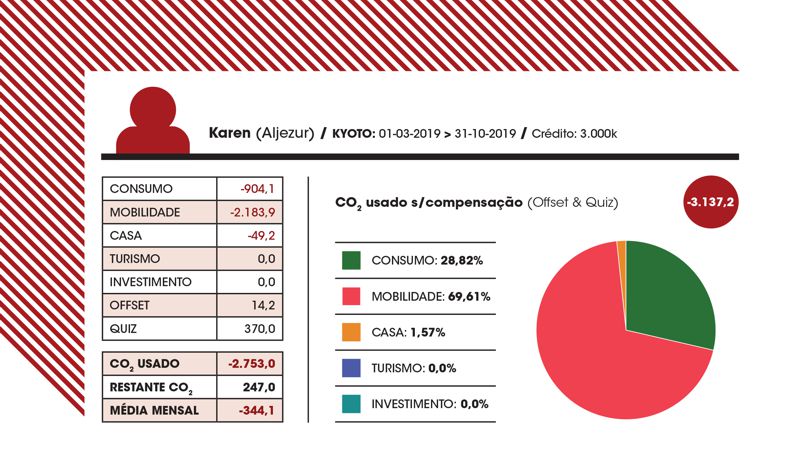
Karen, in Aljezur, is well-informed, and she aims to spend a maximum of 250k per month. It’s an interesting way to approach the challenge, as 3000k per year can also be divided into a monthly allowance. So let’s see how her first eight months went. As a teacher, she showed that she is knowledgeable and, in April and May, she was awarded 80 out of a possible 90 kyotos in the quiz. She sticks to a vegetarian diet, but she sometimes eats fish. In the third and fourth week of June, and in the first week of July, she did not fully complete the questionnaires. She will have to complete this “homework” during March and April of next year, as there are also a few weeks missing in August, September and October, five in total. Even so, she is doing well. Her results in the quiz have dropped a little, and she averages four out of nine correct answers. Two plane journeys, which amount to 1048k, make it difficult for her to finish with a positive balance. In August, she flies again and spends another 780k. After that, we don’t know where she is because we can’t find a record of her return flight. Is she still in Glasgow? She reaches the end of October with a balance of 353.1k. Over the eight months, she has spent almost 2650 kyotos and will need more credit. Her only opportunity to improve on this without using too much energy would involve planting trees next winter in Monchique. She ends up with a balance of 247k.
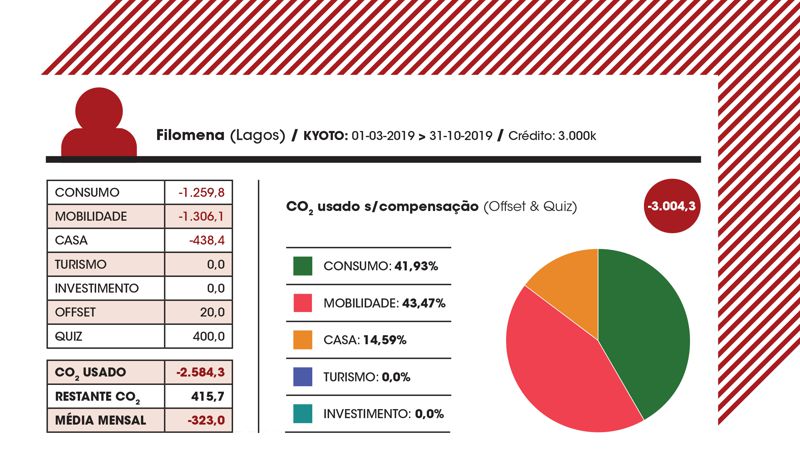
And what is Filomena up to? We are particularly interested in her means of transport. She drives a Suzuki FJ Jimny, which emits 162g of CO2 per kilometre. From her €1000 per month, she has to spend €200 on petrol, a fossil fuel. Was she right about her fears? In March, she spent 122.4k (950km) on travelling by car, sharing one journey with another passenger. She spent 53.5k (1215km) on travelling by train. She also took some short trips by bus, on the metro and hitchhiking, spending another 10.6k. Of the 250k available per month, she spends 186.4k on transport. Now let’s look at the areas of consumption and household energy expenditure. Both are at 188.3k. In the quiz, she regains 50k, ending the first month with 328 less kyotos than when she started. Her balance at this time is 2,672k. After eight months, analysis shows that the different means of transport she uses are responsible for 1,306.1k worth of emissions. This is more than double the amount of emissions that she would like to generate. She has 415.7k left, and this will have to last for another four months. However, perhaps Filomena will plant 100 trees during winter in the new botanical garden in Caldas de Monchique in order to boost her balance.

Diana is from Lisbon, but lives and works in Oslo. She earns around €3,000 a month and finds herself in a similar position to many other people – like a number of our Portuguese readers – who have emigrated to Luxembourg, Switzerland, France or Germany. There are just as many Portuguese people living abroad as there are living in Portugal. Anyone who doesn’t want to stay and earn €900 a month for specialized work has to emigrate. Can you see what we are lacking in Portugal, António Costa? In March 2019, the first month, Diana spends 480.4k. In April, she flies from Oslo to Lisbon (1,404k) and then back again. Altogether, this amounts to 1,538k, more than half of her annual credit. In the following month, she walks, cycles and takes public transport. Her emissions are drastically reduced, down to 7.1k. During the entire month, she only spends 116.6k. Over the next few months, Diana tries to reduce her emissions even further, using only 42k whilst on holiday in Norway. Despite this, she starts October with only 143.9k. What strategy could she employ to complete this year-long challenge? Perhaps Lénia or José can lend, sell or give her a part of their remaining credit.

To conclude, let’s take a look at Elisabete. She wants to see the melting glaciers, so she goes to Iceland with her husband. The situation that she finds there makes her even more worried. Freshwater glaciers are melting into the sea and turning into salt water. Iceland, Nepal, Siberia and Greenland – the effects of climate change can be found everywhere. Elisabete drives a VW Golf and, with or without the rigged software, she releases at least 114g of CO2 per kilometre into the atmosphere. In relation to transport, Elisabete’s emissions total around 100k most months. Her consumption-related emissions are greater. On average, she spends around 300k per month in this area. However, she manages to recover credit by answering many of the monthly quiz questions correctly. The flight that she took to Iceland – for that wonderful holiday – is unfortunate; it affects her otherwise good results, costing 2,019.2k. By the end of October, Elisabete has used up all of her initial balance (3,000k). She is now left with -1,112.9k. How might she continue?

… How can we convince someone to rethink their outlook?
Here is the best way to do it: anything that harms the environment has to be made more expensive, and anything that helps to regenerate it must be made cheaper. A tax on CO2 is currently being discussed; this is the path that Europe must take in the long term. Experts from the Potsdam Institute for Climate Impact Research (PIK – Potsdam Institut für Klimafolgenforschung) recommend a tax for 2020 of €50 per ton of CO2, increasing to €130 per ton by 2030. Fridays for Future demands that CO2 be taxed at €180 a ton, €0.18 euros per kilogram. However, with climate-based policies taking centre stage and solutions desperately being sought, ECO123 wonders if we might not take bolder action. Thinking clearly and objectively, wouldn’t it be better to tax all CO2 emissions above 3000kg at €1 per kilogram? And, in addition to this, states could design a sliding scale: the first ton of CO2 generated – over and above the initial three tons – could cost €1000; the next €1,500 euros, to €2,000, €3,000… with the amount increasing for each additional ton of CO2.
Whenever this subject is debated, the question always comes up as to who would be penalised most heavily by this sort of scheme, with these additional costs for harming the environment. Some experts are worried that the tax would hit people on low incomes hardest, despite the fact that their lifestyles have less impact on the environment than that of people with higher salaries This debate is not always logical. To this day, the proposals of the Kyoto Protocol have not been considered, and they are far from being put into action. Who has read the Kyoto Protocol? If we assume that each citizen starts with the same emissions count at the beginning of the year, then there would not be an unfair tax bill separating the rich from the poor. The goal would be the same for everybody.

If, in 2020, each citizen could emit three tons of CO2 free of charge – and each kilogram of CO2 emitted above this amount were taxed at a rate of €1 – then new policies like an unconditional basic income of €500 per month could be financed. Within such a system, the act of purchasing a plane ticket would be more carefully considered. If politicians really want eco-friendly transport, then train tickets for people who comply with recommended emission levels should be heavily subsidised. In other words, using private means of transport and burning petrol, diesel and jet fuel should be made extremely expensive, while public transport should be made much better and cheaper.
Only in this way can climate protection and social justice be brought together. Everyone would have the same rights and duties in terms of emissions. And the state could then take action by modernising the railways, prioritising investments in renewable energy, banning the production of plastic, and setting up a deposit system for packaging. It could invest in agriculture and forestry, in diversity, and penalise monocultures with a tax on water consumption. And, here too, the goal must be to reduce our consumption of resources, recycling and reusing them instead. How should we proceed? For a long time now, experts have been recommending local and family-based agricultural production, which generates a variety of products. One of the best examples of this is the Herdade do Freixo-do-Meio, in the Alentejo, which cultivates and processes more than 300 different products for its members and for its shop.
Mid-term review
The measures that we can propose based on KYOTO’s first eight months are:
• If train travel between Coimbra and Hamburg were less expensive than plane travel – if the latter were taxed according to the high levels of CO2 that it generates – then Paul’s trip would be more sustainable. The same is true for Diana and her flight between Oslo and Lisbon. “We need clear laws to regulate these things,” said João Camargo in a conversation with ECO123 during the presentation of KYOTO at FCUL. “If not, we will not comply with them.” Flights have to be the least appealing option, even for long distances to go on holiday, and for people who earn a high salary. He also mentions short-haul flights: “Nobody needs to fly to go from Lisbon to Faro or Porto”. Instead of increasing the price of these flights and lowering the cost of train travel, he suggests doing away with short-haul flights altogether.
• José, who has participated in KYOTO since the start of the challenge, lives with his family in a small apartment. Homes with several inhabitants would be at an advantage if there were a CO2 tax, because their emission levels are lower per person than in a house that is heated for just one resident. And shouldn’t all people with eco-friendly lifestyles have access to free public transport?
• Everybody agrees that renovating apartments and houses so that they are more energy efficient should be encouraged through tax incentive schemes. If these incentives were also offered to landlords, Lénia (in the north) and José (in the centre of the country) could also benefit. We would need to establish strict rules in order to achieve success. Firstly, so that this type of policy would affect the rich in the same way as the poor, and, secondly, because these rules “are more effective”, according to João Camargo. Smoking in public spaces didn’t stop due to an increase in the price of cigarettes. It had to be banned.
• There is a lack of clear legislation promoting renewable energies over electricity generated from fossil fuels. “Of course, this would then call into question the way in which we currently live and work,” says the sociologist and author of several books presented in Portugal and across Europe.
• Protecting our climate also depends on knowledge and education. We have to come full circle. In Portugal, the climate protection should be part of the curriculum from the first year of school onwards. Italy is already introducing the subject of climate protection into its curriculum. As it is a game, the KYOTO challenge could also be a useful tool for teaching students. Diana from Oslo agrees: “KYOTO has taught me about the impact of travelling, buying food and shopping. I’m now much more conscientious. I’ve started to fly less, going by train or simply choosing not to travel. I’m actively cutting down on the journeys that I take, and I’m becoming increasingly aware of emissions generated in other areas…”
• Adapting arrangements to suit particular groups is also important, says João Camargo. In the countryside, day-to-day life without a car becomes difficult. “So, let’s say that in cities, at least, we can cut down on car travel.” Careful planning would be necessary – but we have to differentiate between people like José, Diana, Lénia and Elisabete, who live in the city and others like Karen, Filomena and Paul, who live in the countryside. In order to address depopulation in the countryside, it is necessary to put strong policies in place concerning education, health and other public services. This would also include a more flexible public transport system, with buses and trains.
This story will also have to address the role that the economy will play. KYOTO is currently being developed along these lines, with online software to calculate the carbon footprint of companies and events. The protection of our climate and our natural environment should be part of the Portuguese Constitution argues Alfredo Sendim-Cunhal, a KYOTO council member. For this reason, companies must commit to becoming sustainable and not just “greenwash” their practices because it is trendy right now. Protecting the climate is a task for everybody. That’s why it also has to be linked to social and ethical questions and education.
Methodology
The seven participants featured in this report are not representative of Portugal or Europe. Most of the numbers were estimated by us, based on data such as distance travelled to work, time spent flying, the route taken by the train from Lisbon to Oslo and Hamburg, etc. Information on emissions generated by consumption, including recycled and non-recycled waste, as well as emissions generated by transport, fossil fuel energy production and renewable alternatives, was provided by several scientists from the universities of Lisbon and Stuttgart, in collaboration with universities from all over the world and from the Potsdam Institute for Climate Impact Research. KYOTO was programmed using this data, and it is updated annually.

 Eco123 Revista da Economia e Ecologia
Eco123 Revista da Economia e Ecologia

